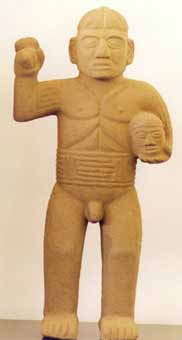Basalt Statue of a Warrior, 500 CE - 1000 CE
Basalt
29
PF.4600
Independent figural sculpture gained prominence for the first time in the Atlantic-Watershed region during Period IV (100- 500 A.D.), probably as a result of changes in ritual activity. The great...
Independent figural sculpture gained prominence for the first time in the Atlantic-Watershed region during Period IV (100- 500 A.D.), probably as a result of changes in ritual activity. The great stone figures served many purposes, all of which were directly related to essential aspects of daily life. Because of the emphasis in Costa Rican religion on human sacrifice, war was a necessity and frequently waged. The warriors who brought back captives were considered as superhuman heroes, protectors of the village, servants of the gods and sex symbols! This gorgeous statue is monumental in its proportions. It shows a victorious warrior carrying a shrunken trophy head of a defeated enemy. He holds an axe (symbol of agricultural fertility and warfare) in his right hand. Ritual scarification on his stomach, arms and legs were marks of prestige and indicators of rank; as was the thick ornate belt around his waist. His nakedness and exposed genitals show his invulnerability and fearlessness in the face of battle. The sex organs also represent fertility of women and the land, both of which were under the protection of the nobility and the warrior class. This statue is larger than life, grand in scope, standing strong through the centuries, unafraid and powerful as the volcanic stone from which it was made.



